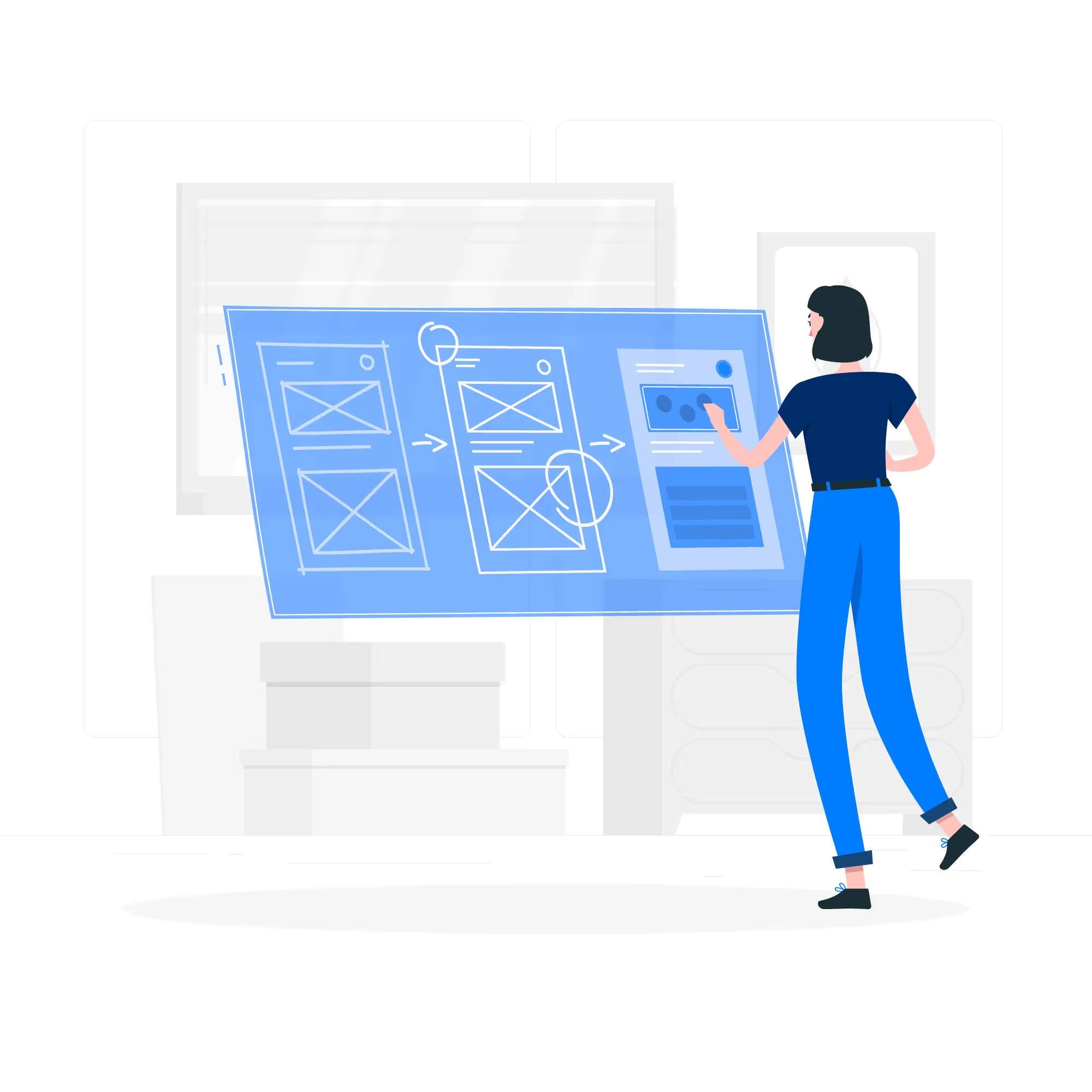If you are ready to enhance your web design with expert solutions, let’s talk!
Modern web design goes beyond aesthetics. It’s all about forging interactive and captivating user experiences. And pagination UX design is an integral part of this experience. No longer confined to being a mere functional requirement, pagination has evolved into a dynamic tool for reshaping user interactions on your website.
At Arounda, a design agency specializing in UI/UX, we are dedicated to enhancing the user experience. Сreating smooth, user-friendly pagination solutions that engage visitors and simplify navigation is part of our expertise.
This article will delve into pagination design. Let’s explore its significance, best practices, and how it can elevate your website’s overall user experience.
What Does Pagination Mean in Web Design?
In UI/UX, pagination design organizes content in user-friendly ways, especially on data-heavy platforms. It can take visible forms, like numbered pages, or be invisible, like infinite scrolling.
Pagination UX Design Mistakes to Avoid
Being aware of pitfalls that may affect your UX goals is crucial. Let’s explore misleading pagination design ideas and share tips to avoid them.
Invisible Navigation Options
One common mistake in pagination design is making navigation options too subtle or invisible. Pagination should indicate where users are, where they’ve been, and where they can go next. This information ensures customers understand how to use the navigation system effectively.
Lack of Intuitiveness
Designing pagination that lacks intuitiveness is another common mistake. Prioritize simplicity and functionality over complexity and aesthetics. Customers will likely use it if they grasp how the navigation works.

Pagination UX Best Practices
Designing effective pagination for your website is crucial for a seamless user experience. Here are some best practices to ensure your pagination is user-friendly.
- Prioritize simplicity. Stick with reliable pagination methods for user-friendliness and effectiveness, even if creative solutions are tempting.
- Use simple enumeration. Use ordinal numerals or letters for pagination to maintain a clear and straightforward design.
- Consider placement. While pagination is often at the bottom of the page, consider your audience and content. Experiment with showing page numbers before products if it suits your site.
- Enable page controls. Provide direct page access for users, especially in large online stores. Add a field for entering the desired page number.
- Strategically place clickable elements. Place pagination at the top and bottom to enhance user experience on long pages. It streamlines access to different pages without excessive scrolling.
- Mind the spacing. Don’t overcrowd the interface. Ensure there’s enough space for users to click page numbers and pagination controls without unintentionally clicking nearby elements.
- Identify the current page. Ensure visitors can quickly identify their position in the pagination sequence by highlighting the current page. It enhances navigation, distinguishing it from other elements like buttons or numbers.
What Is Limitless Scrolling?
Limitless or endless scrolling is a dynamic UI design approach that allows website content to load as users scroll continuously. It eliminates the need for manual page navigation. Limitless scrolling applies to entertainment, social networking, and content discovery platforms. It enhances user engagement, offering a seamless browsing experience.
However, consider the context of when to use pagination versus infinite scroll. For instance, in e-commerce, specific product searches are essential. Therefore, traditional pagination or filtering options provide a better path for users to discover desired items and navigate effectively.
How to Create Effective Pagination Design
Explore our tips to create effective pagination, leading to a smooth user experience.
- Provide large clickable areas. Ensure page links have easy-clickable areas to enable simple navigation without precise clicking.
- Avoid underlines. Don’t underline page links to prevent confusion with hyperlinks. Instead, distinguish them using alternative visual cues such as color or styling.
- Identify the current page. Mark the current page to help users stay oriented and navigate effectively within the content.
- Add spacing between page links. Maintaining spacing between page links prevents accidental clicks and enhances the overall user experience.
- Provide “Previous” and “Next” links. Incorporate “Previous” and “Next” links for sequential content navigation. It offers users a straightforward way to move through your content.
- Use the “First” and “Last” links. Position them on the outer edges of the pagination interface, making them easily accessible for users who want to navigate quickly to the beginning or end of multiple pages.

14 Outstanding UX Pagination Examples
The best way to understand how to implement pagination is to check out websites that have used it effectively.
1. Shopify
Shopify provides diverse pagination designs. These include basic labeled pages, customizable advanced options, a split-screen product layout, and navigation. Also, the platform offers an edge-to-edge design for seamless browsing and a carousel for quick scrolling.
2. Adidas
Adidas uses a unique vertical pagination UX design on its website, departing from the typical horizontal layout. This innovation showcases the business’ dedication to enhancing the user experience through unconventional design choices.
3. AliExpress.com
AliExpress.com, as an online marketplace, employs a traditional pagination system. This method simplifies shopping, helping users efficiently locate products by navigating through numbered pages.
4. iHerb
iHerb, an online store with an extensive product range, implements a practical product structuring system on its website. This pagination simplifies the user experience by eliminating the need for continuous scrolling to find specific products.
5. The Economist
The Economist’s website features a sleek, well-organized pagination design with a fixed header for quick navigation. It presents content clearly, with ample white space and high-quality visuals, creating an appealing and user-friendly layout.
6. Dribbble
Pagination design is essential for Dribbble due to its wealth of creative content. It streamlines navigation and swift access to desired design work, becoming a valuable tool for content discovery on the platform.
7. Amazon
Amazon’s focus on simplicity and functionality enables seamless navigation across pages or direct access to specific ones. This minimalistic approach reduces clutter, ensuring users find products without unnecessary distractions or complexity.
8. FARFETCH
FARFETCH, a famous fashion website, simplifies navigation and offers an extensive product range. Their design features endless scrolling and organized blocks for efficient browsing.
9. Gymshark
Gymshark offers diverse UX design pagination, highlighting its adaptability to different brand identities and user experiences. These include clean, icon-based, minimalist, and responsive designs. They showcase Gymshark’s ability to customize pagination to various styles and needs.
10. The Financial Times
On The Financial Times website, users navigate between pages with the option to move to the next or previous page. It enhances the user experience when accessing the desired headlines and articles.
11. Envato
The Envato platform uses pagination on its blog to organize content. It demonstrates pagination’s versatility in improving the user experience across diverse content platforms.
12. HNHH
HNHH excels in pagination UX design with a clean interface, icon-based page numbers, and a search bar. On top of that, it includes custom graphics, varied fonts, a “load more” button, more convenient loading, and a filter section for refined searches.
13. SEW
SEW website’s pagination system offers straightforward article navigation. With the homepage’s grid format, users explore content by viewing more articles or moving to the next page. Links to previous pages at the bottom improve navigation. Finally, internal linking aids in accessing related articles, ensuring a positive user experience.
14. Google
Google employs next and previous links to improve user experience, providing distinct styling to differentiate from numerical page elements. Designers place these links strategically, away from the page numbers. It minimizes confusion and ensures simple navigation through search results or content, maintaining clarity and usability.
Summary
Pagination evolved into a dynamic and indispensable tool for crafting website user journeys. It offers numerous benefits, from enhancing user experiences to refining website functionality and aesthetics. This transformation leads to stronger brand associations and improves engagement with users.
At Arounda, we optimize pagination UX design to meet our client’s unique requirements. Our expertise ensures seamless integration and a user-friendly experience.
Take your website design to the next level by incorporating the most effective pagination approaches. Contact us today to explore the possibilities and enhance your online presence.














